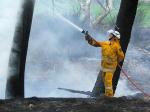Smoke's deadly chemical under fire
University of Adelaide researchers have made a discovery that could help prevent major health problems caused by smoke. A freely available blood pressure drug could be used to block one of the most poisonous chemicals in smoke, according to researchers at Adelaide's Department of Clinical & Experimental Pharmacology and the Department of Chemistry. This may have major implications for the treatment of people affected by smoke inhalation, such as in house fires, bushfires and acts of terrorism. It also opens up new possibilities for the prevention of some illnesses caused by toxic chemicals present within smoke. Why smoke is deadly Smoke comprises a cocktail of hundreds of potentially hazardous substances, one of the most important of which is a highly toxic chemical called acrolein. Acrolein readily attacks proteins and DNA in human cells, especially those of the respiratory tract in victims of smoke exposure. This can cause a range of life-threatening illnesses, including lung and heart disease and cancer, and is one reason why smoke can be more deadly and inflict more injuries than the fire itself. "Injury to the lung by inhaled smoke is receiving increased attention from toxicologists around the world, in part because of the increase in global terrorism," said University of Adelaide toxicologist Dr Phil Burcham (Pharmacology). "For example, lung injury by inhaled smoke was a common problem in hospitalised survivors of the 9/11 attacks in New York three years ago." Dr Burcham and colleague Dr Simon Pyke (Chemistry) have been researching acrolein and its effect on the human body for some years. "Most Aussies love a barbecue, but you're probably less fond of the smoke that emanates from the hotplate when cooking your favourite cut of steak or lamb. Stepping instinctively out of smoke's way is a smart thing to do," Dr Burcham said. "Cigarette smoke contains many deadly substances apart from acrolein, but anyone who doesn't appreciate secondary smoke and wants to get out of a smoky area and into fresh air is also being extremely wise." "Although it's only a small molecule comprising a handful of carbon and hydrogen atoms and a single oxygen, acrolein is very reactive with other substances. To a toxicologist this is bad news." In addition to diseases associated with exposure to smoke, acrolein contributes to many other important diseases. "Over the past decade, a growing body of international research has shown that acrolein participates in tissue damage during ageing, since it forms during damage to lipids (fats) in cell membranes by free radicals," Dr Pyke said. "Free radicals are by-products of normal metabolic processes in all tissues, and contribute to the cell damage that accompanies the ageing process. "Diseases involving cell damage by acrolein formed by this route include degenerative brain diseases such as Alzheimer's disease, fatty deterioration of blood vessels (atherosclerosis) and even kidney diseases affecting diabetic patients." Latest discovery In recent decades, a great deal of effort has been made by researchers to identify antioxidants, drug-like molecules that protect the body against damaging free radicals. However, Dr Burcham and Dr Pyke decided on a different approach: why not identify drugs that block the toxicity of acrolein and related "secondary" or "downstream" products of free radical damage? Over the past few years, together with PhD student Lisa Kaminskas, they have focused much of their effort on hydralazine, a long-standing blood pressure-lowering drug. "We found that this drug is a great scavenger of acrolein, and it blocks toxicity induced by acrolein in cultured cells and also in laboratory animals," Dr Burcham said. Their research recently earned them the cover story in the international journal Organic and Biomolecular Chemistry, published by the Royal Society of Chemistry in the UK. For the paper, Ms Kaminskas carefully studied the chemistry of reactions between acrolein and hydralazine. "Hydralazine is a far from simple drug and it probably works in several ways to block acrolein toxicity," Dr Burcham said. "Figuring out which mechanism is the most important within the body will be a tough ask. However, our work so far has been a big step in the right direction." What the future holds Much of their work to date has been funded by the university's Faculty of Health Science Research Committee, but the researchers and their collaborators are currently seeking additional funds to extend this novel research. "For the future applications of our work, we will be exploring the Alzheimer's disease option first up, but the treatment of smoke inhalation injury will also be a priority," Dr Burcham said. "Since our strategy is fairly experimental, these are still very distant properties. The main drug we've been working with, hydralazine, has some problems with its widespread use, so we will also focus on identifying safer derivatives of the drug." Story by David Ellis
|






